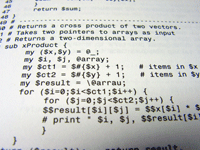|
It started with XSL and ended up with XSLT, XPath, and
XSL-FO.
It Started with XSL
XSL stands for EXtensible Stylesheet Language.
The World Wide Web Consortium (W3C) started to develop XSL because there was
a need for an XML-based Stylesheet Language.
CSS = HTML Style Sheets
HTML uses predefined tags and the meaning of the tags are well
understood.
The <table> element in HTML defines a table - and a
browser knows how to display it.
Adding styles to HTML elements is simple. Telling a browser to display an
element in a special font or color, is easy with CSS.
XSL = XML Style Sheets
XML does not use predefined tags (we can use any tag-names we like), and the
meaning of these tags are not well understood.
A <table> element could mean an HTML table, a piece of furniture, or
something else - and a browser does not know how to display it.
XSL describes how the XML document should be displayed!
XSL - More Than a Style Sheet Language
XSL consists of three parts:
- XSLT - a language for transforming XML documents
- XPath - a language for navigating in XML documents
- XSL-FO - a language for formatting XML documents
|


